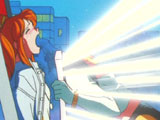

Quick Links:
Sailor Moon Super S, Volume 1
The very mention of Sailor Moon evokes some sort of reaction from most anime fans. For some, it is a fond memory of one's first series. For others, it is a disturbing reminder of the horrors of cosplay. And, for the third group, it is an icon of the magical girl genre. Sailor Moon Super S stands as the fourth of five seasons of the über-popular mahou shoujo series. Saldy, if Super S's first six episodes are any indicator of things to come, it may have been best to leave this disappointment on the drawing board.
From the very beginning, the typical mahou shoujo (magical girl) trappings begin to fall into place. During a total eclipse of the sun, a strange circus tent appears over the city. Conveniently enough, nobody notices (maybe they just don't give a damn), and the populous goes on with its collective life. The citizens should have paid more attention, as the tent is filled with demons, all of whom are searching for the legendary Pegasus. Instead of doing the logical thing and laying siege on the world, the head of the demonic circus sends out her best minions: two womanizing, transvestite men and a woman (I kid you not) that bear the name of "the Amazon Trio". And where do they go first? To a bar to get plastered and look at pictures of women with "beautiful dreams." From this point forward, the show begins to fall into a rut. Every episode on the disc follows the same basic formula: cute, comedic story scenes lead into the inevitable meeting between one of the "Amazon Trio." These chance meetings, oddly enough, flow into fairly obvious instances of symbolic rape before Sailor Moon and company arrive. From this point forward, it's the typical magical girl fare, with the costumed crusaders fighting against some sort of monster [and inevitably winning].
Despite the series' painfully predictable current pace, Sailor Moon still manages to provide some entertainment value. The stories that lead into the "meat" of each episode are laced with funny moments, the most of which come from the exchanges between Usagi and Chibiusa. Unfortunately, there isn't enough substance to really justify the trite battle sequences, insane amount of recycled animation, and very slow plot development. The merits are there, but at this point, the negatives outweigh the positives.
Those hoping that the visual end of things improve are sure to be disappointed. The video suffers from a grainy, flat transfer that makes fine details fairly difficult to distinguish. Furthermore, the colors have a muted, washed-out look to them. For the most part, the animation is typical TV-quality, However, more than a few scenes are recycled from episode to episode, especially during battle segments. The result is a prevailing feeling of "cheapness," and repetitiveness.
At this point, Sailor Moon's sound fares even worse than the video. The Japanese track has a very muffled sound to it, and suffers from noticeable distortion, even at a fairly low volume. The English track seems to be more sound, and features none of the distortion found on the Japanese track. On the flip side, the original Japanese cast is comprised of an all-star lineup that includes Mitsuishi Kotono (Excel Saga, Evangelion), Michie Tomizawa (Sakura Taisen, Bubblegum Crisis), and Aya Hisakawa (Oh My Goddess!, Here is Greenwood), among others. The cast for the English dub casts the group responsible for the televised dubs. As one can guess, the performance is borderline unwatchable. Most of the background music used has been recycled from previous seasons, and would therefore be fairly familiar to veterans of the series. The opening theme is the ever-popular "Moonlight Densetsu," The closing theme, "Wanting to Be Us," is a slower, more melancholy piece performed by Miwako Fujitani.
For the box release, Geneon went the extra mile to present a stellar package for potential buyers. The discs themselves are packaged in attractive white thinpacks, which are collected in an attractive, chipboard box. The first disc's case features an upper-body shot of Sailor Moon set in front of a blue sky background. The back of the case contains a cast list, as well as a description of the disc's contents set in front of a shot of the inner senshi. The main menu features an animated image of Sailor Moon, accompanied by the selections. The submenus are fairly simple, and feature the selections accompanied by stills from the show. The sole extra on the disc is the original Japanese opening, which suffers from the same visual and audio problems found on the rest of the disc.
With thirty-six episodes remaining in the season, there is still plenty of time for Super S to pull itself out of the rut it has fallen into. Hopefully, by volume two, some of this so-called "legendary quality" will show through and redeem the mediocre action found in these first six episodes.
Distributor: Geneon Entertainment Creator: Naoko Takeuchi Released: 2004
Video Quality: C- Audio Quality: D Presentation: B Content: D+ Overall: D+



